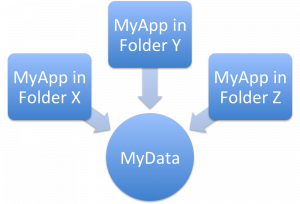Today, merged applications save many information in the application package and also in the compiled file (.4DC). Besides preventing to create read-only applications, saving information in the application package has another annoying consequence: the information gets lost when you update the application.
To retain them, we must retrieve the information before to update your application, then reinstated after. Thus, this system is cumbersome.
To allow read-only applications, 4D will be modified in future versions step by step to reallocate this information.
In v15 R4, the Data file path and server connection information can be stored in the user preferences, if you use the new Use new architecture for application deployments compatibility option.
For example, if the developer deploys an updated application to his customer, the last data file location is not overwritten. When the end user launches the structure, it will find the old data file without user interaction.
Data file path
For merged standalone and merged server applications, if you save the data file path in the user preferences, two modes are available to link the application to the data file.
By application name (default)
In this mode, the 4D application automatically opens the most recently opened data file that corresponds to the structure file. This flexible and intuitive mode allows you to move the application package freely on the disk.

By application path
In this mode, the merged application will open the data file linked to the application’s full path. This mode allows you to duplicate your merged application package a number of times, and have each one use its own data-file. However, with this option, if you move or rename an app package on the disk, you modify the application full path. As a result the moved/renamed app package will lose the link to its data file.

Server connection information
For merged client applications, when the client successfully connects to the Server, the client saves the server connection information in the user preferences.
Another interesting point: the developer has now control on whether the client application displays the server selection dialog when a connection attempt fails. By default it’s no longer displayed and you can change this by using a new buildapp XML key.
For more details, please take a look at the 4D v15 R4 Upgrade manual.

